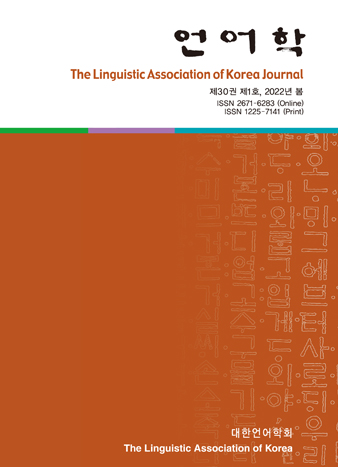대한언어학회 전자저널

30권 1호 (2022년 3월)
- 한국어 연결어미 “-고”의 무표성: “문 닫고 나가”를 중심으로
-
정인기 김지영
Pages : 93-112
Abstract
Chung, Inkie & Kim, Jiyoung. (2022). A markedness-theoretic account of the Korean verbal suffix -ko in mun tat-ko na-ka. The Linguistic Association of Korea Journal, 30(1), 93-112. Native speakers of Korean have no problem understanding the intended meaning of the utterance Mun tat-ko na-ka. In fact, the expression may seem to carry semantic absurdity as it literally means Close the door, and go out! Thus, studies have tried to analyze its meaning focusing on its pragmatic function, the semantic features of -ko, and the meaning span of the verb na-ka Go out! However, no studies have tried to focus on its syntactic structure and the pragmatic role of the two conjuncts. In this paper, we show that the first conjunct mun tat-ko close the door carries the principal meaning of Mun tat-ko na-ka and the whole utterance is syntactically designed to make a request of the second conjunct na-ka go out. Also, we propose to attribute the interpretability of Mun tat-ko na-ka to the unmarkedness of the suffix -ko because it does not seem to add any meaning while connecting two clauses in seemingly reverse order. This proposition is testified by analyzing sentences with other semantic exceptionality. Finally, we demonstrate why -ko corresponds to the characteristics of the unmarked member of a certain linguistic category, as proposed by Jakobson (1932/1984) and Greenberg (1966). Compared to other Korean suffixes with similar meanings, -ko is the most frequently used suffix with the most versatile functions and is the one children acquire first.
Keywords
# 한국어 연결어미 -고(Korean verbal suffix –ko) # 문 닫고 나가(Mun tat-ko na-ka ‘Close the door # and go out!’) # 담화표지 좀(discourse marker com) # 도상성(iconicity) # 유표성(markedness)
References
- 국립국어연구원. (1999). 표준국어대사전. 서울: 두산동아.
- 국립국어원. (2005). 현대 국어 사용 빈도 조사 2. Retrieved on Dec. 27, 2020, from https://www.korean.go.kr/common/all/reportData/download.do?report_seq=1
- 권승호. (2020). 삶의 무기가 되는 속담 사전. 서울: 지노.
- 권재일. (2012). 한국어 문법론. 서울: 태학사.
- 김지영. (2012). ‘문 닫고 나가’: 한국어의 접속어미 ‘-고’에 대한 고찰. 언어와 정보사회, 17, 85-100.
- 남기심. (1995). 국어 연결어미의 쓰임. 서울: 서광학술자료사.
- 서희선, 이승환. (1999). 2-5세 정상 아동의 연결어미 발달. 언어청각장애연구, 4(1), 167-185.
- 송인성, 신지영. (2014). 담화표지 {좀}의 기능과 형태운율적 특성의 실현 양상. 한국어학, 62, 315-339.
- 안주호. (2009). 축약형 담화표지 “좀/막”에 대한 연구. 한국사전학, 14, 199-223.
- 운평어문연구소. (1992). 그랜드 국어사전. 서울: 금성출판사.
- 윤평현. (2005). 현대국어 접속어미 연구. 서울: 박이정.
- 이한규. (1999). 문닫고 나가라고?: 비논리의 논리. 언어연구, 17, 59-66.
- 이희승. (1974). (1995 수정판). 엣센스 국어사전. 서울: 민중서림.
- 장경희. (1995). 국어 접속 어미의 의미 구조. 한글, 227, 151-174.
- 조명한. (1982). 한국아동의 언어획득 연구: 책략모형. 서울: 서울대학교 출판부.
- 주경희. (2004). ‘좀’ 문법화의 의미화용론적 연구. 국어교육, 115, 433-454.
- 최호철. (2015). 문장 발화 “문 닫고 들어와.”의 의미 해석. Journal of Korean Culture, 30, 63-90.
- Chomsky, N. (1981). Lectures on government and binding. Dordrecht: Foris.
- Durand, J., & Prince, T. (2015). Phonological markedness, acquisition and language pathology: What is left of the Jakobsonian legacy? In C. Astesano & M. Jucla (Eds.), Neuropsycholinguistic perspectives on language cognition: Essays in honour of Jean-Luc Nespoulous (pp. 15-30). London: Routledge.
- Givón, T. (1991). Markedness in grammar: Distributional, communicative and cognitive correlates of syntactic structure. Studies in Language, 15(2), 335-370.
- Goodglass, H., & Geschwind, N. (1976). Language disorders. In E. Carterette & M. P. Friedman (Eds.), Handbook of perception: Language and speech Vol. VII (pp. 390-428). New York: Academic Press.
- Gundel, J. K., Hedberg, N., & Zacharski, R. (1993). Cognitive status and the form of referring expressions in discourse. Language, 69(2), 274-307.
- Jakobson, R. (1932/1984). The structure of the Russian verb. Reprinted in L. R. Waugh & M. Halle (Eds.), Roman Jakobson: Russian and Slavic grammar: Studies 1931-1981 (pp. 1-14). Berlin: Mouton de Gruyter.
- Jakobson, R. (1941). Kindersprache, Aphasie und allgemeine Lautgesetze. Uppsala: Almqvist & Wiksell. Translated by A. R. Keiler. 1968. Child language, aphasia, and phonological universals. The Hague: Mouton.
- Lyons, J. (1977). Semantics. Cambridge: Cambridge University Press.
- Sweetser, E. (1990). From etymology to pragmatics: Metaphorical and cultural aspects of semantic structure. Cambridge: Cambridge University Press.
- Trubetzkoy, N. S. (1939). Grundzüge der Phonologie. Prague: Prague Linguistic Circle. Translated by C. Baltaxe. 1969. Principles of phonology. Berkeley, CA: University of California Press.
- Waugh, L. R. (1982). Marked and unmarked: A choice between unequals. Semiotica, 38, 299-318.